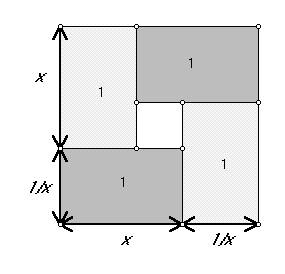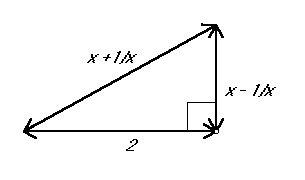MATH 240 Introduction to Mathematical
Thought
Spring, 2012 Class
Summaries
- Tuesday, Jan. 17. First class:
Review of the structure of the course.
- Keys to success in this course:
- Active and regular participation.
- Open to new ways of organizing your thinking.
- Communicating often and regularly with others both in oral
and written forms.
- Aim for EXCELLENCE!
- Keep a sense of humor .
- Activity Discussion (5-10 minutes):
- With a Partner discuss how Figure 1 can be used to
"prove" : x + 1/x >= 2.
One partner(A) should write the "proof" while the other
partner(B) checks to see the writing fully reports their
understanding.
 Figure 1
Figure 1
- With the same partner discuss how Figure 2 can be
used to "prove" : x + 1/x >= 2.
Now partner B should write the "proof" while the other
partner (A) checks to see the writing fully reports their
understanding.
 Figure 2
Figure 2
- [indicates material of interest not discussed in class.]
- Two concepts from Solow: Unification and Generalization.
- Examples of unification related solving equations such as
3x=15, 3x=24; then 3x=7 and 3x=N.
- Considered methods to solve these- especially 3x=15.
- guess and check.
- "Guess": x=5.
- Check: 3*5 = 15 . Notice the check here resorts to
common experience and background- as well as
understanding of what constitutes a solution.
- symbolic recognition of patterns, and
- algebraic solution using analysis. - "showing your
work"
- consolidated version: x = 3x/3 = 15/3 = 5.
- "step by step" version:
3x = 15
1/3(3x) = 1/3 (15)
x = 5
- "two column analysis"
Statement
|
Reason
|
3x = 15
1/3(3x) = 1/3 (15)
x = 5 |
Given
"Equals multiplied by equals give equals."
1/3(3x) = x; 1/3(15) = 5; "Transitivity of
equality."
|
This approach can be more thorough but can still leave
out some details.
- Comparison with a calculus problem: Find `int_0^1
x^3 dx`.
- An answer was proposed, 1/4, but there was no
comparable way to "check this answer"
- Show the work: (1)`int_0^1 x^3 dx = 1/4x^4 |_0^1 = 1/4
- 0 = 1/4`
Notice that some of this work is notational and the key
step involves the "Fundamental Theorem of Calculus."
- Both problems are looking for a number as an answer
that is described in a context, but the answer in the
first one has a context that provides a way to "check",
while the integration problem relies on a
"theorem" to justify its correctness.
- Comparison with (2) `int_{-1}^1 1/{ x^2}dx = -1/x
|_{-1}^1 = -1 - (-1) = -2` [THIS IS AN ERROR!].
- Consideration of the area interpretation of the
definite integral shows there must be something wrong
with (2). The error lies in the application of the
fundamental theorem - the hypothesis that the
function be continuous on a closed and bounded interval
is not satisfied in (2) because `1/{x^2}` is not
continuous at `x=0`.
- Consider 3x=7.
- Both a guess and check and analytic approach can
work here.
- It now becomes noteworthy that a solution for this
problem may not exist if the only type of solution that
makes sense is with natural numbers or integers. The
solution here in the context of common arithmetic needs
to have a number called "seven thirds."
- The context of a problem is important in understanding
what an acceptable solution may be. This feature of the
problem is sometimes left unstated or may be made
explicit in the statement by words like "suppose x is a
natural number.. " or " if x is any real number and... "
- Discuss the solution to the unification in Ax=B being
solved by x= B/A.
This follows the analytical process to arrive at a "closed
form" solution.
- A generalization of this problem in algebra :
Any (quadratic) polynomial will have a root - possibly
involving a complex number.
- another context to examine Unification and generalization.
- Show: if f(x) = x2 then f '(3) = 6.
- use limits and the definition of the derivative.
- Move directly to a generalization that f '(a) = 2a.
- demonstrate directly again using the definition of the
derivative and limits.
- Discuss: one could do similar work to show that if f(x)=
x3 then f '(x) = 3x2
- one could arrive at a unification in the statement:
If n is a natural number and f(x) = xn
then f '(x) = nxn-1.
- If we think of n as a negative integer, say -4, then
this is an example of generalization because the statement
of the result extends to instances which are not
covered by the common experience with 2 and 3.
- Likewise we can generalize the result to f(x) = xr
where
r is any fraction or more generally any real number,
but a proof of that result might involve much more
complicated arguments.
- Some fundamental discussion of sets....
Introduction to Sets
Representation of Set
Basics(Equality, Subset, Etc)
Optional
on-line exercises 1
Set Operations
Optional
on-line exercises 2
Properties of Set Operation
- Proofs: Conditionals and "forward backward"
A discussion of a homework problem related to generalization.
The first problem generalize from a quadratic expression in x
to a general real valued function of x. The second problem
(more difficult) generalized a specific linear inequality in two
variables to a more general linear inequality in two variables, and
then to three variables, and finally to n - variables. Also under
this problem was the relation of (0,0) to the inequality and how
that would be involved in the generalization.
- Some important sets that we will consider this term are as
follows:
| the natural numbers |
N |
{1,2,3,...} or {0,1,2,3,...} |
| the integers |
Z |
{0,1,-1,2,-2, ... } |
| the rational numbers |
Q |
{ n/m where n and m are integers and m not 0} |
| the real numbers |
R |
{ numbers that can be represented as decimals} |
The issue of being a member of a set can be an issue of
the nature of the set or the nature of the object. For
example, we can consider sqrt(2) and ask, "is this a real
number?" "Is this a rational number?" To determined if sqrt(2)
is a member of R,we
must have a way to determine this number as a decimal, that is
to determine what digit would be in the kth decimal place for
any k. Now this is possible through some estimaton procedures,
though there is no closed form solution to determine the kth
decimal place of the sqrt(2). On the other hand the sqrt(2) is
not a member of the rational numbers. This is not because the
rational numbers have a problem with the definition of that
set, but is a question of mathematics to demonstrate that this
number cannot be expressed as a ratio of integers as required
by definition for membership in the set of rational numbers.
The nature of the subset relation. Focus on the importance
of recognizing the universal set involved in a discussion. Thus
for example the set {x: 0 = 10 + 2x + x2} is an
empty set if the universe is the real numbers, but contains
two members if the universe is the set of complex numbers, C.
Some examples of sets of
functions... C0 = { continuous real valued functions
defined on all the real numbers} and C1 = {
differentiable real valued functions defined on all the real
numbers}. The issue was whether these sets are equal.
the subset relation : when set A is a subset of a
set B. The definition of this term can be made in
the form of an absolute statement: "every element of A is an
element of B" or as a conditional statement: " if f is
an element of A then f is an element of B".
Observe that C1 is a subset of C0.
To prove this we suppose that f is a member of C1and
thus f is a differentiable function. It is a result of
the calculus course that if a function is differentiable, then
it is continuous. Thus f is a continuous function, which
means it is a member of C0 .
To consider the related issue,
we ask "Is C0 a subset of C1
?" Here the answer is : NO. To show that this is
true we examined the function f (x)= |x|.
This function is continuous for all real numbers, but is not
differentiable at x = 0. This gives an instance where
the conditional requirement for a subset fails, since the
hypothesis is true for this function but the conclusion is
false. The example also shows why the absolute statement
is false by giving a single member of C0 which is
not a member of C1 . This lead to a discussion
of the truth or falsity of conditional and universal
absolute statements in mathematics.
How to prove sets are equal using A={ 2, -2} and B = {x
: x2 = 2}.
(i) First, A is a subset of B. This is demonstrated by checking
the equation of B for x = 2 and x = -2.
(ii) Then it is neceassary to show that B is a subset of A. For
this we suppose x is an element of B, so that x2
= 2, and then x2 - 2 = 0, so (x
+2)(x-2)
= 0. considering the last equation, together with the fact
that if the product of 2 real numbers is 0, then one of the
factors is 0, we see that either x = -2 or x =
2. In either case, x is a member of A.
- The discussion focussed again on finding the truth values for
complex statement using conjunction (and), disjunction (or),
conditional (if..then), and negations (not).
We then discussed how simple statements appeared in compound
statements using "and", "or", "if...then", and "not" and how to
determine the truth of the compund sentence from knowing the
truth of the simple statements. We examined wht there were 4
possible ways to have truth values for a pair of simple
statements and how these would deteremine the truth value of a
compund statement using a "truth table."
| A |
B |
A and B
|
If A then B |
|
T
|
T
|
T
|
T
|
|
T
|
F
|
F
|
F
|
|
F
|
T
|
F
|
T
|
|
F
|
F
|
F
|
T
|
This discussion will be continued next class.
- 2/3 The discussion focussed again on
finding the truth values for complex statement using conjunction
(and), disjunction (or), conditional (if..then), and negations
(not).
A proposition is called a tautology if it is true
without regard to the truth or falsity of any of its component
statement.
A proposition A is said to be equivalent to another
proposition B is the truth value of A is the same
as the truth value of B for any choice of truth values for its
primitive components.
We also considered the connective "if and only if", <->,
called the biconditional. It has the following truth table:
| A |
B |
A <->B
|
|
T
|
T
|
T
|
|
T
|
F
|
F
|
|
F
|
T
|
F
|
|
F
|
F
|
T
|
Proposition: The proposition A is equivalent to the
proposition B when and only when the proposition A<->B isa
tautology.

